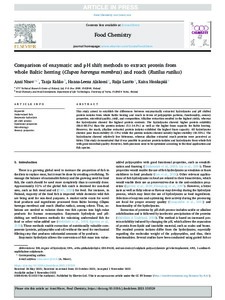Comparison of enzymatic and pH shift methods to extract protein from whole Baltic herring (Clupea harengus membras) and roach (Rutilus rutilus)
Nisov Anni; Kakko Tanja; Alakomi Hanna-Leena; Lantto Raija; Honkapää Kaisu
https://urn.fi/URN:NBN:fi-fe2021120158405
Tiivistelmä
This study aimed to establish the differences between enzymatically extracted hydrolysates and pH shifted protein isolates from whole Baltic herring and roach in terms of polypeptide patterns, functionality, sensory properties, microbial quality, yield, and composition. Alkaline extraction resulted in the highest yields, whereas the hydrolysates showed the highest protein contents. The hydrolysates showed higher protein solubility (86.0–88.5%) than the protein isolates (5.1–14.5%) as well as the higher foam capacity for Baltic herring. However, for roach, alkaline extracted protein isolates exhibited the highest foam capacity. All hydrolysates showed poor foam stability (0–13%) while the protein isolates showed notably higher stability (30–55%). The hydrolysates showed relatively low bitterness, whereas alkaline extracted roach proteins were perceived as bitter. This study demonstrated that it was possible to produce protein isolates and hydrolysates from whole fish with good microbial quality. However, both processes need to be optimised according to the food application and fish species.
Kokoelmat
- Rinnakkaistallenteet [27094]
